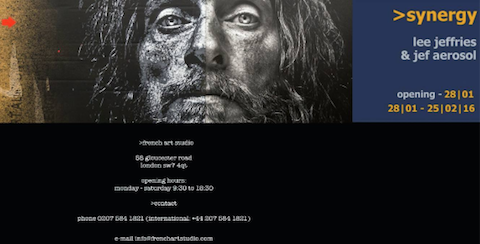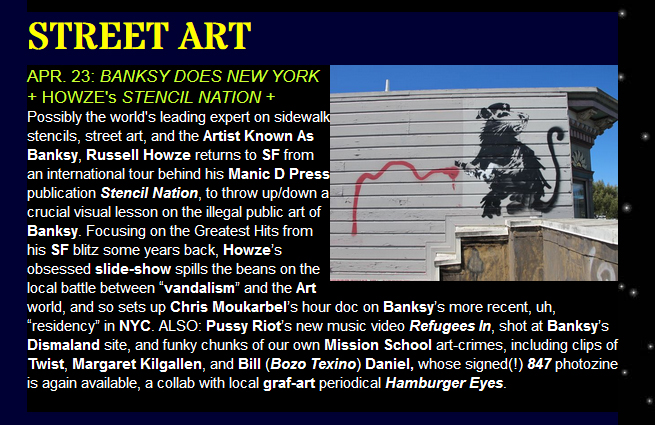Since 2002 (updated often), your old-school website for all things stencils. Photo, video, links, and exhibit info submissions always welcome. Enjoy and stay curious.
Donate any amount to support this DIY site.
Buy Stencil Nation or take a tour
Our best photos on Instagram and flickr.
The Dude Company (FR)
Passionné par la technique du pochoir, Etienne Bergot alias The Dude Company a commencé à peindre dans la rue.
Ses voyages Outre Atlantique, en Europe et en Inde ont guidé ses créations.
Attiré par la ville, les paysages urbains restent son domaine de prédilection tout autant que la recherche du détail.
Ses nouvelles compositions, réalisées à partir des photos de récentes balades citadines mettent en scène Berlin, Bruxelles, Lille sa ville natale.
Elles constituent le début d’une collection signée The Dude Cities.
Jan 29: Synergy: Jef Aerosol, Lee Jeffries (London)
 JEF AEROSOL & LEE JEFFRIES
JEF AEROSOL & LEE JEFFRIES
"SYNERGY"
29/01 > 25/02/2016
opening / vernissage : 28/01/2016 (18h > 21h)
THE FRENCH ART STUDIO GALLERY, LONDON
Synergy – When photography and stencil interact
[synergy: interaction of elements to produce a combined effect greater than the sum of their separate effects]
‘Synergy’ is an artistic and social encounter between French street artist Jef Aérosol and British photographer Lee Jeffries.
Stemming from the original ‘Synergy’ exhibition that took place in Paris at Mathgoth gallery in March 2015, this collaboration casts a new light on a sensitive topic: the homeless.
A Lawyer Talks about Copyrights in Street Art
6 Things You Must Know About Copyrights in Street Art
Megan Ralstin for Art Law Journal
Artist’s rights in their street art, whether commissioned or guerrilla, has been in the news with some frequency lately, largely due to suits against American Eagle and Terry Gilliam. The slippery nature of copyright law has left many wondering where to draw the line between taking a photograph with street art in the background and taking a photo that infringes on a copyright. Unfortunately, there are no easy answers. As we have pointed out before, artwork used without permission may not be considered an infringement. Rather, unauthorized use exists on a spectrum with clear infringement on one end and fair use on the other.
Miami’s Wynwood district has become a hotspot for street art. Recently, American Eagle used murals from one of Miami’s most well-known street artists, AholSniffsGlue, in its latest advertising campaign. Thanks to Ahol’s suit against American Eagle, many Miami artists have been wondering what rights they may have in the art that they have created on public walls on public streets. At the same time, many photographers, journalists, and bloggers have been wondering if they are exposing themselves to liability when they photograph street art.
To help clear up some of the confusion, LegalLink, a legal resource for artists organized by Cannonball, hosted a lecture with a question-and-answer segment in Miami, Florida on September 17th. As well as answering audience questions, the presenter pulled representative comments from news websites to illustrate come commonly held misconceptions about copyright in public art. You can watch the entire presentation and download the PDF here.
New Uploads, Passing 21,000 photos
 21,000 uploads to the Stencil Archive. Here's to 1,000s more.
21,000 uploads to the Stencil Archive. Here's to 1,000s more.
Respect to all who have submitted, cut, painted, photographed.
Thanks to: Larry, Daryl, Mark, Mona, Pod
SJEL
Banksy
XLterrestrials
Paris (just one)
Mexico (just one)
FAILE
Colorado (just one)
East Bay, Cal
Kentucky
North Carolina
South Carolina (just one)
>NEW< PUSH
Eclair
Clarion Alley, SF
SoMa
Tenderloin (just one)
Upper Haight
A Journey to the Oldest Cave Paintings in the World
 A Journey to the Oldest Cave Paintings in the World
A Journey to the Oldest Cave Paintings in the World
The discovery in a remote part of Indonesia has scholars rethinking the origins of art—and of humanity
By Jo Marchant
The Smithsonian Magazine, January 2016
I struggle to keep my footing on a narrow ridge of earth snaking between flooded fields of rice. The stalks, almost ready to harvest, ripple in the breeze, giving the valley the appearance of a shimmering green sea. In the distance, steep limestone hills rise from the ground, perhaps 400 feet tall, the remains of an ancient coral reef. Rivers have eroded the landscape over millions of years, leaving behind a flat plain interrupted by these bizarre towers, called karsts, which are full of holes, channels and interconnecting caves carved by water seeping through the rock.
We’re on the island of Sulawesi, in Indonesia, an hour’s drive north of the bustling port of Makassar. We approach the nearest karst undeterred by a group of large black macaques that screech at us from trees high on the cliff and climb a bamboo ladder through ferns to a cave called Leang Timpuseng. Inside, the usual sounds of everyday life here—cows, roosters, passing motorbikes—are barely audible through the insistent chirping of insects and birds. The cave is cramped and awkward, and rocks crowd into the space, giving the feeling that it might close up at any moment. But its modest appearance can’t diminish my excitement: I know this place is host to something magical, something I’ve traveled nearly 8,000 miles to see.
Scattered on the walls are stencils, human hands outlined against a background of red paint. Though faded, they are stark and evocative, a thrilling message from the distant past. My companion, Maxime Aubert, directs me to a narrow semicircular alcove, like the apse of a cathedral, and I crane my neck to a spot near the ceiling a few feet above my head. Just visible on darkened grayish rock is a seemingly abstract pattern of red lines.
VOX Tracks Kilroy Across WWII War Zones (Video)
We know about the epic drama of World War II, but what about the jokes? The above video tells the story (as best as we can). The iconic piece of graffiti that was known, in America, as "Kilroy Was Here" traveled the world in a fashion remarkably similar to a modern meme.
Theorem Art in Williamsburg, VA
 Colonial Williamsburg presents theorem art at Abby Aldrich Rockefeller Folk Art Museum
Colonial Williamsburg presents theorem art at Abby Aldrich Rockefeller Folk Art Museum
By HOLLY PRESTIDGE Richmond Times-Dispatch | Posted: Saturday, December 5, 2015 10:30 pm
“Theorem work,” a popular method of watercolor stencil painting on fabric, wood and paper, was used to decorate everyday objects and create decorative pictures in the 19th century.
An exhibit highlighting the artwork, which was popular as a skill for women, is on display in Colonial Williamsburg.
“Folk art enthusiasts have long associated the art of stencil with 19th-century collections, and we’re excited to share this important and vibrant form of American art with the public,” Laura Pass Barry, Colonial Williamsburg’s Juli Grainger curator of paintings, drawings and sculpture and manager for curatorial outreach, said in a release. “This exhibit will not only depict a variety of theorem compositions and subjects, but it will also show the period process which artists, schoolgirls, and everyday men and women followed to create these colorful creations making them today one of the country’s most recognized and celebrated folk art traditions.”
New Dec. Photo Upload on Stencil Archive
 The TARDIS gets a stencil. More surprises in store for today's Stencil Archive uploads. Music support by WRAS, WREK, and KTRU. Rainy December day in San Francisco. Enjoy things indoors with more stencils.....
The TARDIS gets a stencil. More surprises in store for today's Stencil Archive uploads. Music support by WRAS, WREK, and KTRU. Rainy December day in San Francisco. Enjoy things indoors with more stencils.....
Mexico (thanks, Larry)
Istanbul (thanks, Jef)
In Media (Doctor Who)
East Bay, California
Los Angeles (just one)
North Cal (just one; thanks, Josiah and Celeste)
NYC (just one)
>NEW< wrdsmth (LA, CA)
CK1
Eclair
fnnch
Kate DeCiccio
MR
>NEW< Sash
>NEW< Solis
MORE LINKS AFTER THE BREAK
Bustart (CH)
There is no technique Bust doesn’t use in his pictures. Freehand with paint-brushes, markers and cans or stencils up to 8 layers. For him, there’s no limit!

